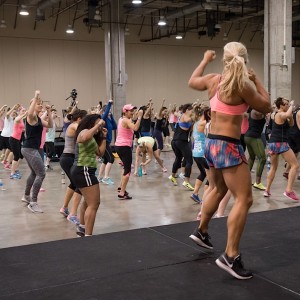HOW TO CHOOSE A GROUP WORKOUT : How to Tell if That Group Exercise Class is a Good Fit for You
How to choose the best group fitness class. I am an huge fan of the power of group fitness and accountability. Group fitness is something that can’t be replaced. The energy, the music, the push to go past your comfort zone, and so much more. It has been proven that participants in a group fitness class will push their intensity harder and longer just because they can’t pack up their stuff and quit so easily. The FUN factor is a lot higher in a group fitness class as well, and that makes exercise less like torture. And finally, the comrade and team support of the other members is comparable to none.
 All the research on motivation, willpower, and behavior change has pointed to the benefits of community support with behavior change, and we can even see it throughout human history: groups have always outperformed individuals trying to change their behavior.
All the research on motivation, willpower, and behavior change has pointed to the benefits of community support with behavior change, and we can even see it throughout human history: groups have always outperformed individuals trying to change their behavior.
But as great as the right group is, the wrong group can really set back your efforts to make lasting behavior change. I’ve been teaching group fitness for almost 25 years. I have trained the TOP presenters and master trainers in the fitness professional world. I have presented at major fitness conventions as well as continue to film workout training videos for Turbo Kick and PiYo instructors for the company Beachbody.
WHAT should a GREAT class FEEL like? 
- Welcoming. Not only from the instructor teaching the class, but the other participants. if you see a bunch of participants standing there with their arms crossed, waiting for the class to begin OR head down on their smartphones to avoid conversations with anyone else in the room, that may not be a good sign that this class is for you. It should feel welcoming, energetic, friendly, supportive, and possible.
- Doable (even if it’s challenging). The order of exercises, form and technique, and more importantly modifications are critical to a group fitness class success. EVERY group fitness class should be possible no matter your fitness level. If the instructor is a GOOD instructor, they will know how to handle a brand new reconditioned participant down to the most athletically trained member. The goal for the instructor should be to help everyone feel successful throughout the entire class. It is NOT the instructors shining moment to show off their skills, intensity, and sergeant mentality of “do it or get out.”
- Connected. You should feel connected to the format, type of exercise, music, and feel confident that this class is going to benefit you, not hurt you.
Here are some signs to look for that show this class might NOT be for you:
- You do not connect with the instructor. if you don’t respect the instructor or put your trust in your time in them, then this class/instructor is not for you. The format may fit your need, but the instructor may not be up your alley. If you find yourself making faces, rolling your eyes, watching the clock wishing for the class to be over, annoyed with their motivation, instruction, mannerisms, then this is a clear sign to never come back.
- Anyone makes you feel bad, guilty, shameful, or inadequate. Research has shown that people get more results from coaches who make them feel positive, empowered, and competent. A lot of bad trainers use words that make people feel that way because they think those feelings motivate people. And they do motivate people… to quit.
- Anyone who places firm hard rules on how you should complete the class. Intensity levels, health history, conditioning, goals, are just a few of the variables of each participant in the class. As an instructor, they shouldn’t label or put firm hard rules on how you should complete the class, under their intensity, restriction, longevity, form, etc. If they don’t allow you to feel successful and understand the different levels of performance during the exercises or section, that instructor can not be trusted.
- A cold HARD room. A strong community shows it by being welcoming and encouraging, not acting like mean girls. They should introduce themselves to you and be excited to tell you why the class is so awesome.
- Super NEGATIVE or GOSSIPY participants. Negative talk or gossip can ruin your attitude, involvement, community, support, and so much more. That type of environment fuels even more negativity and only produces a super negative environment. Working out is hard enough, you shouldn’t have to feel protective or defensive.
- The exercises don’t make sense. A good instructor stays on top of their game. They are educated, stay with fitness trends, and has a good routine that flows nicely. If you keep wondering the effectiveness of the majority of the exercises, hurt yourself, don’t feel the intensity, over do intensity, as well as if you keep questioning the effectiveness of the class, this class and/or instructor is not for you.
- Departure. A great instructor and coach will always do their best to invite participants to chat after class as well as to make everyone feel appreciated that they spent their time with them. The instructor should do their best to chat with new participants, or say goodbye and thank you to people as they leave.
Use these general tips to try out a new class and instructor. Use your gut instincts but don’t be a big baby and bail if you feel uncomfortable and out of place on your first day of the class. Truth is, everything new is new. You have to learn the flow of the class, what equipment is normal, how people interact with each other, and how the instructor leads. It may not be exactly how you have done things in the past or how “Suzie” your old favorite instructor use to do them. BUT keep an open mind and be open to training differently.

